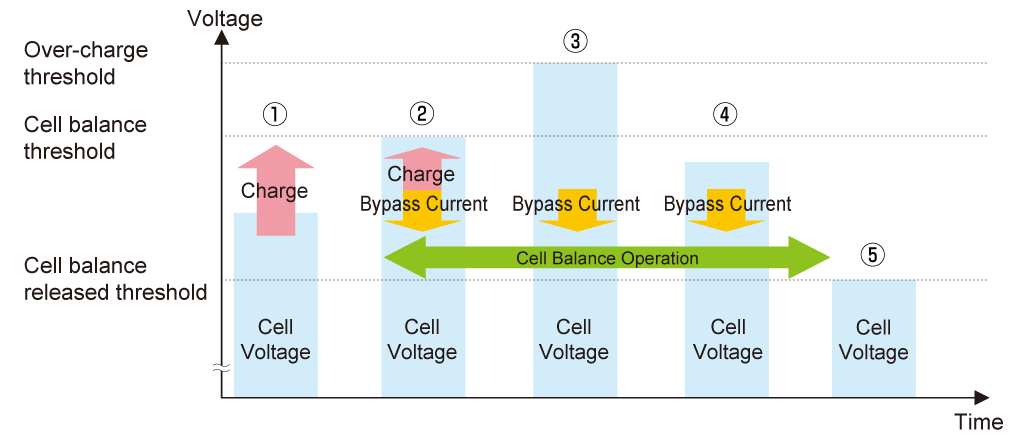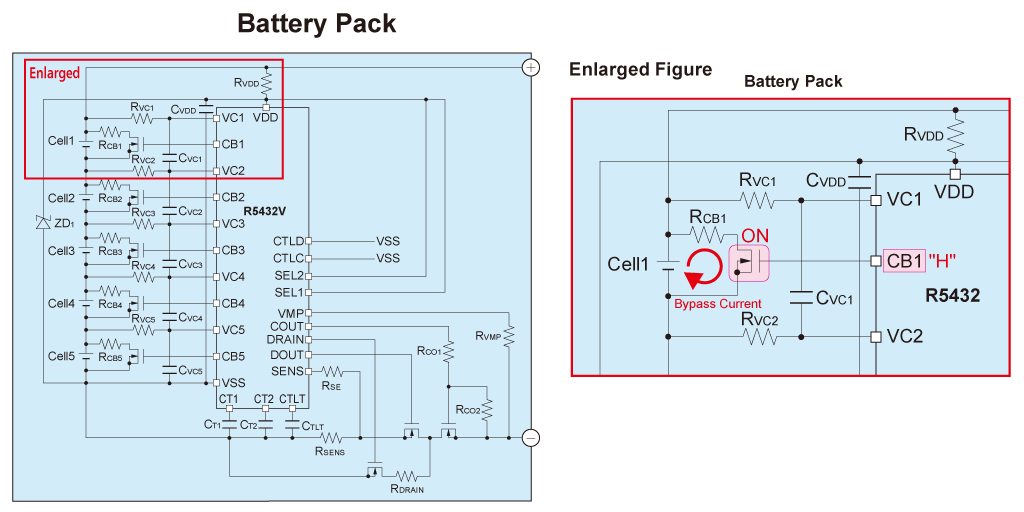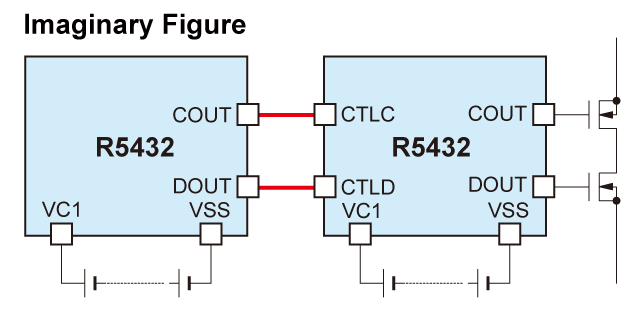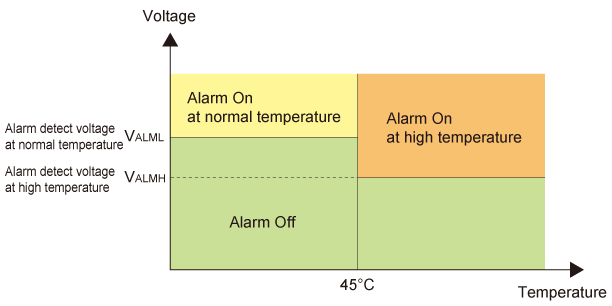Protecting Li-ion Batteries: Optional Functions and Advantages
Today, Li-ion batteries are widely used in many electrical devices such as cell phones, tablet PCs and portable video games. Although Li-ion batteries are convenient thanks to their rechargeability, they could go out of control without proper protection. To support designing Li-ion-battery-powered systems of high safety, we provide Li-ion battery protection ICs equipped with variety of optional protection functions.
- Short-circuit Current Protection
- 0-V-charge Prohibition
- Cell Balancing
- Cascade Connection
- Temperature Protection
- Alarm
- Open-Wire Detection
- 1-cell
- 2-cell
- Multi-cell
Short-circuit Current Protection
Short-circuit state between external electrodes causes Li-ion battery cells to discharge to the limit of their capacity and generate heat. If the temperature increases and the battery becomes overheated, the internal structure (especially a separator) of a Li-ion battery can be damaged, which may lead to dangerous situations such as toxic-fume emission, fire and explosion.
A short-circuit current protection can cut off a discharge current within 1 micro second after detecting a short-circuit current. Though it is functionally similar to a discharge overcurrent protection, this short-circuit protection features its fast response to a large discharge current.
Adopted Products::all the 1-/2-/multi-cell protection ICs except the R5433
- 1-cell
- 2-cell
- Multi-cell
0-V-charge Prohibition
Whether recharge of 0 V cells (fully discharged cells) is accepted or not is determined by product version.
0-V-charge prohibited Version:
Charging operation is prohibited if the cell voltage decreases to a voltage level below the overdischarge detection voltage.
A Li-ion battery without guarantee for 0-V charging may be under internal short-circuit state by metal deposition penetrating its separator when its voltage is lower than or equal to a certain value.
Charging a Li-ion battery under internal short-circuit state can raise the battery’s internal temperature, which leads to dangerous chemical reactions causing gas emission, self-ignition, and, even worse, explosion.
Li-ion battery protection ICs with 0-V-charge prohibition can protect batteries, devices and systems from these risks by prohibiting dangerous charging operation.
0-V-charge Acceptable Version:
This version allows charging 0-V cells. It is suitable for Li-ion batteries which guarantee secure 0-V charge. This version enables an exhausted Li-ion battery to regain its original performance as much as possible.
Adopted Products
1-cell
・ selectable: R5405, R5494, R5487, R5497, R5471
・ Prohibited Only: R5480, R5486
2-cell
・ selectable: R5461, R5462, R5464
・ Prohibited Only: R5463
Multi-cell
- Multi-cell
Cell Balancing
A cell balancing function equalizes cell voltages of multi-cell Li-ion batteries by bypassing a charge current or by discharging cells with a higher voltage.
Cell voltages of multi-cell Li-ion batteries become out of balance due to individual cell differences such as capacity and leak current. The unbalance stops charging operation when the highest-voltage cell reaches its charge-end voltage regardless of the state of the other lower-voltage cells. On the other hand, the lowest-voltage cell reaches its discharge-end voltage faster than the other higher-voltage cells. The unbalancing state narrows the specification range substantially, reduces the actual capacity of a multi-cell Li-ion battery, and deteriorates the lifetime of the system and the battery.
By monitoring and equalizing the voltage state of each cell with a cell balancing function, it is possible to maintain the actual capacity of a multi-cell Li-ion battery.
Adopted Products: R5432V, R5436T

- (1) Charging operation starts on a cell with a lower cell voltage than the cell balance threshold.
- (2) In the cell voltage exceeding the cell balance threshold, the cell balancing pin (CB pin) turns high, the N-channel transistor on, and a cell balance operation starts.
A bypass current flows in the direction of the arrow to suppress a charge current flowing to the cell. - (3) When the cell voltage reaches the over-charge threshold, cell charging stops after the output delay time.
- (4) Even after cell charging being stopped, the cell balance operation continues until the cell voltage becomes lower than the cell balance release threshold. The bypass current continues to flow, decreasing the cell voltage.
- (5) When the cell voltage reaches the cell balance release voltage, the CB pin becomes low, the N-channel transistor off, and the cell balance operation stops.
 A Case of Cell Balancing Operation in Cell 1
A Case of Cell Balancing Operation in Cell 1
- Multi-cell
- 2nd.
Cascade Connection
Some of our multi-cell Li-ion battery protection ICs adopt cascade connection, which makes it possible to protect batteries with 6 or more cells.
For example, by connecting two 5-cell Li-ion battery protection ICs with their COUT and DOUT pins, those ICs can protect a 10-cell Li-ion series battery. Cascade connection enables protection ICs to support multi-stage batteries even though there are no ICs capable of monitoring those batteries with a single chip.
Besides, in some cases, multiple ICs with cascade connection can be less expensive than a multi-cell battery protection IC with high-voltage resistance.

- 1-cell
- Multi-cell
Temperature Protection
A temperature protection function detects the abnormal temperature increase of a Li-ion battery and stops charging / discharging operation to prevent dangerous situations.
Basically, our temperature protection function adopts a method of connecting an NTC thermistor and a resistor as a voltage divider in series to detect abnormal temperatures.
Adopted Products
- 2-cell
Alarm
A Li-ion battery protection IC with an alarm function monitors temperature and a cell voltage with an external thermistor and the alarm pin. In detecting the cell voltage exceeding the alarm detection voltage, the IC outputs an alarm signal to a charger. This detection voltage switches over from the one at normal temperature to the other at high temperature when the thermistor detection temperature exceeds 45℃.
Overcharging a Li-ion battery at high temperature may shrink and damage the separator inside the battery. This leads to internal short-circuit state causing dangerous accidents such as gas emission, self-ignition, and explosion. By using a Li-ion battery protection IC with an alarm function, a system can notice overcharge state against temperature before the real danger occurs and take countermeasures such as stopping charging operation.
In Japan, two-stage overcharge protection for Li-ion Batteries is prescribed by Electrical Appliance and Material Safety Act*. Protection ICs with this alarm function can meet the requirements in just a single chip.
* Other countries have similar regulations.

Adopted Products: R5461K, R5464K,(R5466K)
- Multi-cell
Open-Wire Detection
An open-wire detection function detects open wires between cells and protection circuits in a multi-cell Li-ion battery.
As for products such as electric power tools, there are risks of becoming open-wire by vibration. Under open-wire condition, protection ICs cannot monitor the state of Li-ion battery cells and therefore cannot judge whether the battery is safe or not.
Protection ICs with an open-wire detection function monitor the connection with battery cells periodically. In detecting an open wire, the protection circuit prohibits charging / discharging operation to avoid dangerous situations.







